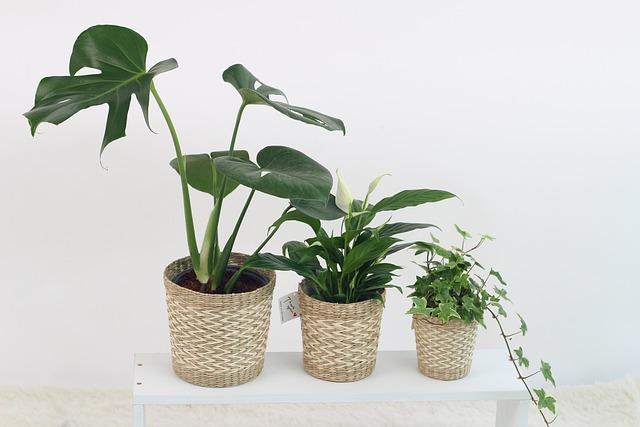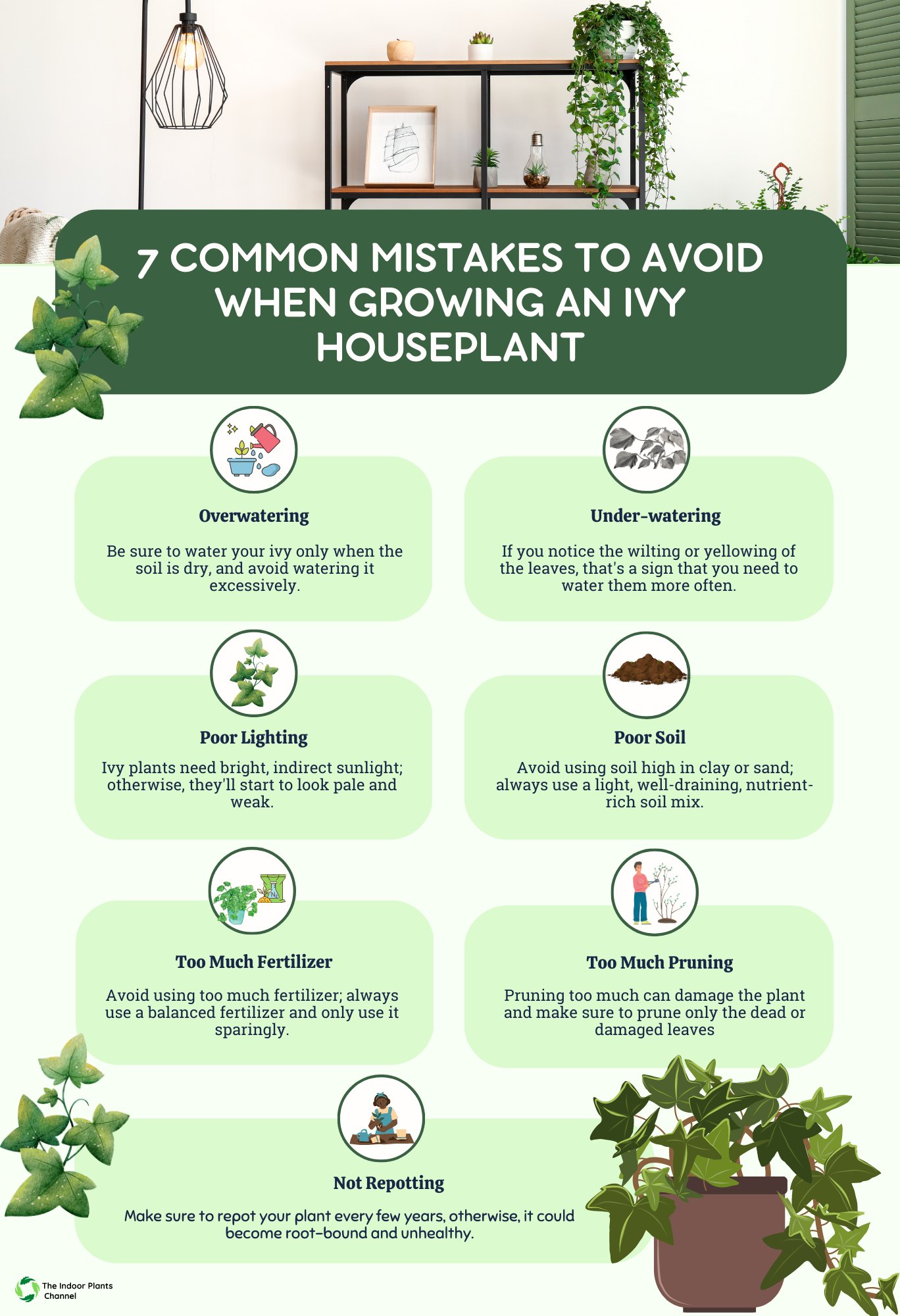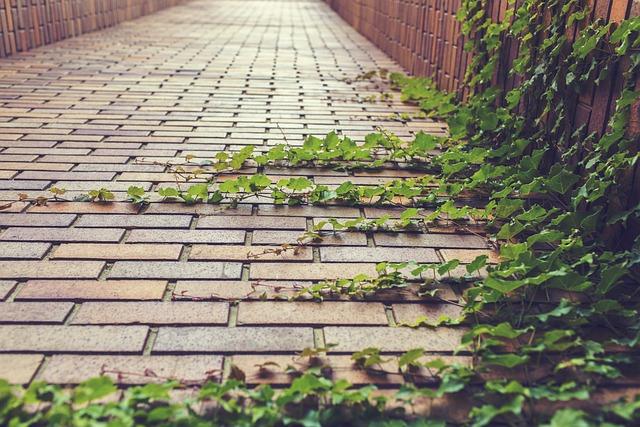Growing an ivy houseplant is a rewarding and fun experience, but it does require some special care. Ivy houseplants thrive in the best temperature, fertilizer and adequate watering. If you want to ensure that your ivy houseplant is healthy and thriving, there are some common mistakes that you should avoid.
By taking the time to research the proper care and maintenance techniques, you can make sure your ivy houseplant will last for many years to come.

We’ve highlighted what you should know about Ivy houseplants in this post. So, keep reading!
Choosing The Right Location For Your Ivy Houseplant
Choosing the right location for your ivy houseplant is essential for its growth and overall health. The right location will help your plant thrive and make it look beautiful. Here are some things to consider when selecting the perfect spot for your ivy houseplant:
1. Light
Ivy houseplants need bright, indirect light to stay healthy and thrive. Avoid placing your ivy houseplant in direct sunlight, as it can cause the leaves to scorch and die. Choose an area with bright, indirect light such as a north or east-facing window.
2. Temperature
Ivy houseplants prefer temperatures between 60-75 degrees Fahrenheit. Keep your plant away from drafts or air conditioners, as these can cause the leaves to dry out.
3. Humidity
Ivy houseplants need high levels of humidity to grow and stay healthy. You can increase the humidity around your plant by using a humidifier, misting the leaves, or placing the pot on a tray of wet pebbles.
4. Soil
Ivy houseplants need well-draining soil to prevent root rot. Choose a light and airy potting mix with plenty of organic matter, such as peat moss or coco coir.
5. Watering
Ivy houseplants need to be watered regularly, but not too often. Check the soil before watering to ensure that it’s dry before you give it more water. Overwatering can cause the leaves to turn yellow and fall off.
6. Fertilizer
Ivy houseplants need to be fertilized every two weeks during the growing season. Use a balanced liquid fertilizer and follow the instructions on the package for the correct amount.
7. Pruning
Ivy houseplants need to be pruned regularly to keep them looking their best. When pruning, remove dead or damaged leaves and stems. Pruning will help the plant stay healthy and look its best.
Common Mistakes To Avoid When Growing An Ivy Houseplant
Growing an ivy houseplant is an easy way to add some greenery to your home. While the process is simple, there are some common mistakes to avoid in order to ensure your plant stays healthy and grows properly.

Here are some of the most common mistakes to avoid when growing an ivy houseplant:
1. Overwatering
One of the most common mistakes made when growing an ivy houseplant is overwatering. Ivy plants need to be watered regularly, but not excessively. Make sure to water your ivy only when the soil is dry, and avoid watering it in excess.
2. Underwatering
Another common mistake made when growing an ivy houseplant is under-watering. Ivy plants need to be watered regularly, so make sure to check the soil to make sure it’s not too dry. If you notice the leaves of your ivy plant starting to wilt or turn yellow, that’s a sign that you need to water it more often.
3. Poor Lighting
Ivy plants need bright, indirect sunlight in order to thrive. If your ivy is not getting enough sunlight, it will start to look pale and weak. If you can’t give it enough natural light, consider investing in a grow light to help supplement its lighting needs.
4. Poor Soil
Poor soil can be a major issue when it comes to growing an ivy houseplant. Make sure to use a light, well-draining soil mix that’s rich in nutrients. Avoid using soil with high levels of clay or sand, as this can cause the plant to become waterlogged and unhealthy.
5. Too Much Fertilizer
Fertilizer is an important part of keeping your ivy houseplant healthy, but too much can be damaging. Make sure to use a balanced fertilizer, and only use it sparingly. Avoid using too much fertilizer, or you might end up burning the roots of your plant.
6. Pruning Too Much
Pruning is an important part of keeping your ivy houseplant healthy, but it’s important to prune it correctly. Make sure to prune only the dead or damaged leaves, and avoid pruning too much. Pruning too much can damage the plant and make it look unsightly.
7. Not Repotting
Repotting your ivy houseplant is important in order to give it room to grow. Make sure to repot your plant every few years to give it enough space to thrive. If you don’t repot your ivy, it could become root-bound and unhealthy.

Watering Your Ivy Houseplant
Watering your ivy houseplant is an important part of keeping it healthy and happy. While it is important to not over-water your houseplant, it is also essential to make sure it gets enough water.

Follow these tips to ensure that your ivy houseplant gets the perfect amount of water.
When it comes to watering your ivy houseplant, the key is to strike a balance. It’s important to avoid both over-watering and under-watering your ivy houseplant. Over-watering can cause root rot, while under-watering can cause the leaves to dry out and die.
-
The best way to water your ivy houseplant
The best way to water your ivy houseplant is to give it a good soak once a week. That is, you should water it until the soil is completely saturated and water starts to come out of the drainage holes in the bottom of the pot. Let the water soak in for a few minutes and then empty out any excess water from the saucer.
-
Soil moisture
It is also important to check the soil moisture level of your ivy houseplant regularly. Stick your finger into the top inch of soil and if it feels dry to the touch, it is time to water your ivy houseplant. If the soil is still damp, wait a few days before watering.
-
Type of water
You should also be careful about the type of water you use for your ivy houseplant. Tap water contains chlorine and other minerals that are not good for your plant. It is best to use filtered or rainwater for your ivy houseplant.
-
Fertilizer
Finally, you should make sure to fertilize your ivy houseplant on a regular basis. Fertilizer will provide the essential nutrients that your ivy houseplant needs to thrive. Look for a fertilizer specifically designed for houseplants and follow the instructions on the label.
Sunlight Requirements For An Ivy Houseplant
When it comes to sunlight requirements, ivy houseplants generally prefer bright, indirect light. This means that the plant should be placed in a spot that receives a few hours of indirect sunlight each day, such as near a window that gets morning sunlight.

It’s also important to be aware of the temperature in the room where your ivy houseplant is located. Ivy house plants typically don’t do well in temperatures above 75 degrees Fahrenheit, so if the room is too warm, the plant should be moved to a cooler spot. Additionally, ivy houseplants can suffer from too much light, so if the leaves start to turn yellow and become discolored, it’s likely due to too much sun exposure.
Using The Right Soil Type For An Ivy Houseplant
The type of soil you use when growing an ivy houseplant will depend on the type of ivy you’re growing. Different types of ivy have different soil needs. Generally speaking, ivy houseplants need soil that is well-draining, moisture-retentive, and has a neutral pH.
- For soil that is well-draining, use a mixture of potting soil, peat moss, and perlite. This will ensure that your ivy houseplant isn’t sitting in water for too long and will allow for optimal drainage.
- For soil that is moisture-retentive, use a mixture of potting soil, compost, and worm castings. This combination will help to retain moisture while also providing essential nutrients to the plant.
- When it comes to pH levels, ivy houseplants prefer soil with a neutral pH. This means that the soil should have a pH between 6.5 and 7.5. To check the pH level of your soil, you can purchase a pH testing kit from your local garden center or online.
- It’s also important to note that ivy houseplants need to be repotted every few years. This will help ensure that the plant has access to fresh soil with the right nutrients and pH levels. When repotting your ivy houseplant, make sure to use a pot that is slightly larger than the previous one. This will allow the roots to spread out and grow.
Pruning And Trimming An Ivy Houseplant
Before you begin pruning and trimming your ivy houseplant, it is important to understand the different types of pruning and trimming that are available.
- Pruning is the process of removing dead or dying leaves and stems from a plant. It can be done with either secateurs or a sharp pair of scissors.
- Trimming is the process of cutting the plant back to a desired shape. This can be done with a pair of scissors or a hedge trimmer.
When pruning an ivy houseplant, it is important to make sure that you are only removing dead or dying leaves and stems. This will help to promote healthy new growth. It is also important to ensure that you are not pruning too much at once, as this can shock the plant and damage the roots.
When trimming an ivy houseplant, you should be careful not to trim too much. Trimming too much can cause the plant to become lopsided or deformed. You should also make sure that you are not trimming off too much of the stem or leaves, as this can damage the plant.
When pruning and trimming an ivy houseplant, it is important to use sharp tools. Blunt tools can cause damage to the plant and can lead to infection. It is also important to make sure that you are wearing gloves when pruning and trimming, as this will help to protect your hands and arms from any prickles or thorns that may be present.
Also, keep in mind that pruning and trimming can be stressful for an ivy houseplant. Therefore, it is important to only prune and trim when necessary. If you find that the plant is not growing as desired, then it is best to wait until the plant is healthier before pruning and trimming.
Finally, remember that pruning and trimming an ivy houseplant is not a one-time task. Always prune and trim regularly to keep the plant healthy and looking its best.
Controlling Pests And Diseases On An Ivy Houseplant
When growing an ivy houseplant, it is crucial to keep pests and diseases in check. Different pests and diseases can affect ivy plants, so it is important to know how to identify them and take steps to prevent and control them.

Here are some tips to help you protect your ivy houseplant from pests and diseases.
- The first step in controlling pests and diseases on an ivy houseplant is to inspect it regularly. Look for signs of pests, such as small holes in the leaves or damaged areas on the stems.
- Also, look for any signs of disease, such as wilting leaves, discolored spots, or other abnormal growth. If any of these signs are present, it is important to take action quickly to prevent the problem from getting worse.
- The next step is to make sure the ivy houseplant is getting the right amount of light, water, and nutrients. Too much or too little of any of these can make the plant more vulnerable to pests and diseases.
- Ivy plants prefer indirect sunlight, so make sure to place them in a spot that gets plenty of indirect light. Additionally, make sure to water your ivy houseplant regularly, but do not over-water it. Finally, feed your ivy houseplant with a balanced fertilizer once or twice a month.
- If your ivy houseplant has pests or diseases, the best course of action is to remove the infected leaves or stems. If the problem is severe, you may need to use an insecticide or fungicide to help get rid of the pests or diseases. Make sure to follow the instructions on the product carefully, and only use it as a last resort.
- Finally, it is important to practice good hygiene when handling your ivy houseplant. Make sure to wash your hands before and after handling the plant to prevent the spread of pests and diseases. Additionally, make sure to clean any tools you use to prune or otherwise care for the plant.
Bonus Tips
- Provide ample sunlight to your ivy houseplant and rotate the pot regularly to ensure it grows evenly.
- Water your ivy houseplant regularly and make sure the soil is evenly moist but not overly saturated.
- Prune your ivy houseplant regularly to keep it looking neat and healthy.
- Keep an eye out for pests and disease and treat the plant accordingly.
- Repot your ivy houseplant every two years to ensure it has enough room to grow.
- Avoid overwatering your ivy houseplant, as too much water can lead to root rot.
Frequently Asked Questions
-
What are the most common mistakes when growing an ivy houseplant?
The most common mistakes when growing an ivy houseplant include not providing enough light, overwatering, not pruning regularly, not fertilizing, not potting correctly, not providing the right environmental conditions, and not repotting in time.
-
How much light does an ivy houseplant need?
Ivy houseplants need at least four to six hours of indirect sunlight every day. If you cannot provide this much light, then you can use artificial lighting to supplement the natural light.
-
What happens if I overwater my ivy houseplant?
If you overwater your ivy houseplant, it can cause root rot and other diseases. Too much water can also lead to stunted growth or discoloration of the leaves.
-
How often should I prune my ivy houseplant?
You should prune your ivy houseplant at least once a month. Pruning helps to encourage new growth and keep your plant looking healthy.
-
What environmental conditions should I provide for my ivy houseplant?
Your ivy houseplant should be kept in a temperature of between 65 and 75 degrees Fahrenheit. It should also be kept in an area with high humidity, such as a bathroom or kitchen.
-
How often should I repot my ivy houseplant?
You should repot your ivy houseplant every two years or so. Repotting will help to ensure that your plant is getting enough nutrients and room to grow.
Conclusion
Ivy houseplants can be an excellent addition to any home, but they require a specific type of care in order to stay healthy and thrive. By avoiding these 7 common mistakes, you can ensure that your ivy houseplant has a long and healthy life. With a little bit of knowledge, patience, and dedication, you can have a beautiful and resilient ivy houseplant to enjoy for years to come.
Michelle Wilde
Related posts
![]()
About Michelle Wilde
Michelle Wilde is a stay-at-home mom and avid plant lover. Armed with a post-graduate degree in Computer Science (no kidding!), she loves researching plants and landscapes. When she is not caring for her 4 kids, she spends time on her passion for plants. She blogs at www.indoorplantschannel.com, the trusted source for indoor plants.
Learn more
Subscribe
* You will receive the latest posts and updates about indoor plants!
Search
Recent Posts
Categories
- Beginner Guides (10)
- FAQ (206)
- General (2)
- How-To Guides (212)
- Indoor Plants (214)
- Pest Management (2)
- Plant Problem Solutions (4)
- Seasonal Growing (2)
- Specialized Environments (2)
- Specific Plant Care (3)
- Technical Growing (2)